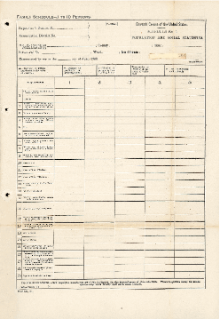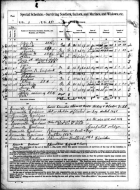Decennial Census of Population and Housing Questionnaires & Instructions
Decennial Census of Population and Housing Questionnaires & Instructions
Here you will learn whether an archive of past questionnaires - also known as schedules or forms – is available online. Many of our surveys now offer an online response in place of completing and mailing a printed form.
1890 Census
About the 1890 Questionnaires
The census act of 1880 replaced the marshals and their assistants with specially appointed agents (experts assigned to collect technical data, such as on manufacturing processes), supervisors, and enumerators, every one of whom was forbidden to disclose census information. Maintaining the confidentiality of the data was a result of what some people regarded as the census’ invasion of privacy, especially since prior to the 1880 census, there was no law limiting the extent to which the public could use or see the information on any schedule.
The Federal Government provided blank printed forms for the enumerators. For the first time, enumerators were given detailed maps to follow, so they could account for every street or road and not stray beyond their assigned boundaries.
The general scope of the 1880 census was expanded only slightly over that of 1870, but much greater detail was obtained for many of the items—so much more that, beyond the basic counts, which were released promptly, publication of these data was not completed until nearly 1890.
The 1879 census act provided for the collection of detailed data on the condition and operation of railroad corporations, incorporated express companies, and telegraph companies, and of life, fire, and marine insurance companies (using Schedule No. 4 - Social Statistics). In addition, the Superintendent of Census was required to collect and publish statistics of the population, industries, and resources of Alaska, with as much detail as was practical. An enumeration was made of all untaxed Indians within the jurisdiction of the United States to collect as much information about their condition as possible.
The following five schedules were authorized by the 1880 census act:
About the 1890 Census Questionnaires
For 1890, the Census Office changed the design of the population questionnaire. Residents were still listed individually, but a new questionnaire sheet was used for each family. Additionally, this was the first year that the census distinguished between different East Asian races.
Across the top of the sheet were several organizational questions:
Enumeration
Because June 1 was a Sunday, the 1890 enumeration began on June 2. The census employed 175 supervisors, with one or more appointed to each state or territory, except Alaska and the Indian Territory. Subdivisions assigned to a single enumerator were not to exceed 4,000 inhabitants. In cities designated by 1880 census results to have populations under 10,000, the enumeration was to be completed within two weeks. Enumerators were required to collect all information required by the act by a personal visit to each dwelling and family.
The 1890 questionnaire retained almost all of the inquiries from the 1880 census, and a few new questions were added. The 1890 census included a greater number of subjects than any previous census and more than would be included in those immediately following. New entries included questions about ownership and indebtedness of farms and homes; the names, as well as units served in, length of service and residences of surviving Union soldiers and sailors and the names of the widows of those who had died. Another new question dealt with race, including "Japanese" as a category for the first time, along with "Chinese," "Negro," "mulatto," "quadroon," "octoroon," and "white."
The population schedule was changed so that a separate sheet was used for each family, irrespective of the number of persons included.
As in 1880, experts and special agents were hired to make special enumerations of manufactures, Indians living within the jurisdiction of the United States, and a separate enumeration of Alaska. Furthermore, the schedule collecting social statistics was withdrawn from enumerators; the work of obtaining statistics concerning mines and mining, fisheries, churches, education, insurance, transportation, and wealth, debt, and taxation, also was conducted by experts and special agents.
For the first time, enumerators were given detailed maps to follow so they could account for every street or road and not stray beyond their assigned boundaries.
Instructions to Enumerators
-
2020 Census QuestionnaireLearn how the Decennial Census questionnaires have changed through the decades and download questionnaires from each Census decade.
-
2010 Census Questionnaires
-
2000 Census Questionnaires
-
1990 Census Questionnaires
-
1980 Census Questionnaires
-
1970 Census Questionnaires
-
1960 Census Questionnaires
-
1950 Census QuestionnairesView an archive of the 1950 Census questionnaires.
-
1940 Census Questionnaires
-
1930 Census Questionnaires
-
1920 Census Questionnaires
-
1910 Census Questionnaires
-
1900 Census Questionnaires
-
1890 Census Questionnaires
-
1880 Census Questionnaires
-
1870 Census Questionnaires
-
1860 Census Questionnaires
-
1850 Census Questionnaires
-
1840 Census Questionnaires
-
1830 Census Questionnaires
-
1820 Census Questionnaires
-
1810 Census Questionnaires
-
Questionnaire1800 Census QuestionnairesIn 1800, marshals took the census in existing states and territories northwest of the Ohio River and Mississippi Territory.
-
Questionnaire1790 Census QuestionnairesIn 1790, marshals took the census in the original 13 states; plus the districts of Kentucky, Maine, and Vermont; and the Southwest Territory (Tennessee).
1890 Questionnaire - General Population
- Number of dwelling house in the order of visitation by enumerator
- Number of families in the dwelling house
- Number of persons in the dwelling house
- Number of this family in order of visitation by enumerator
- Number of persons in this family
The following questions, listed by row number, were asked of each individual resident:
- Christian name in full, and initial of middle name
- Surname
- Was this person a soldier, sailor, or marine during the Civil War (U.S.A. or C.S.A.), or the widow of such a person?
- Relationship to the head of the family
- Race
Enumerators were instructed to write "White," "Black," "Mulatto," "Quadroon," "Octoroon," "Chinese," "Japanese," or "Indian." - Sex
- Age
- Was the person single, married, widowed, or divorced?
- Was the person married within the last year?
- How many children was the person a mother of? How many of those children were living?
- Person's place of birth
- Place of birth of person's father
- Place of birth of person's mother
- How many years has the person been in the United States?
- Is the person naturalized?
- Has the person taken naturalization papers out?
- Profession, trade, or occupation
- Number of months unemployed in the past year
- How many months did the person attend school in the past year?
- Can the person read?
- Can the person write?
- Can the person speak English? If not, what language does he speak?
- Is the person suffering from an acute chronic disease? If so, what is the name of that disease and the length of time affected?
- Is the person defective of mind, sight, hearing, or speech? Is the person crippled, maimed, or deformed? If yes, what was the name of his defect?
- Is the person a prisoner, convict, homeless child, or pauper?
- Depending on the person's status in the questions in rows 22, 23,or 24, the enumerator would indicate on this line whether additional information was recorded about him on a special schedule
The following questions, located at the end of each family's questionnaire sheet were asked of each family and farm visited:
- Was the home the family lived in hired, or was it owned by the head or by a member of the family?
- If owned by a member of the family, was the home free from "mortgage incumbrance?"
- If the head of the family was a farmer, was the farm which he cultivated hired or was it owned by him or a member of his family?
- If owned by the head or member of the family, was the farm free from "mortgage incumbrance?"
- If the home or farm was owned by the head or member of the family, and mortgaged, what was the post office address of the owner?






